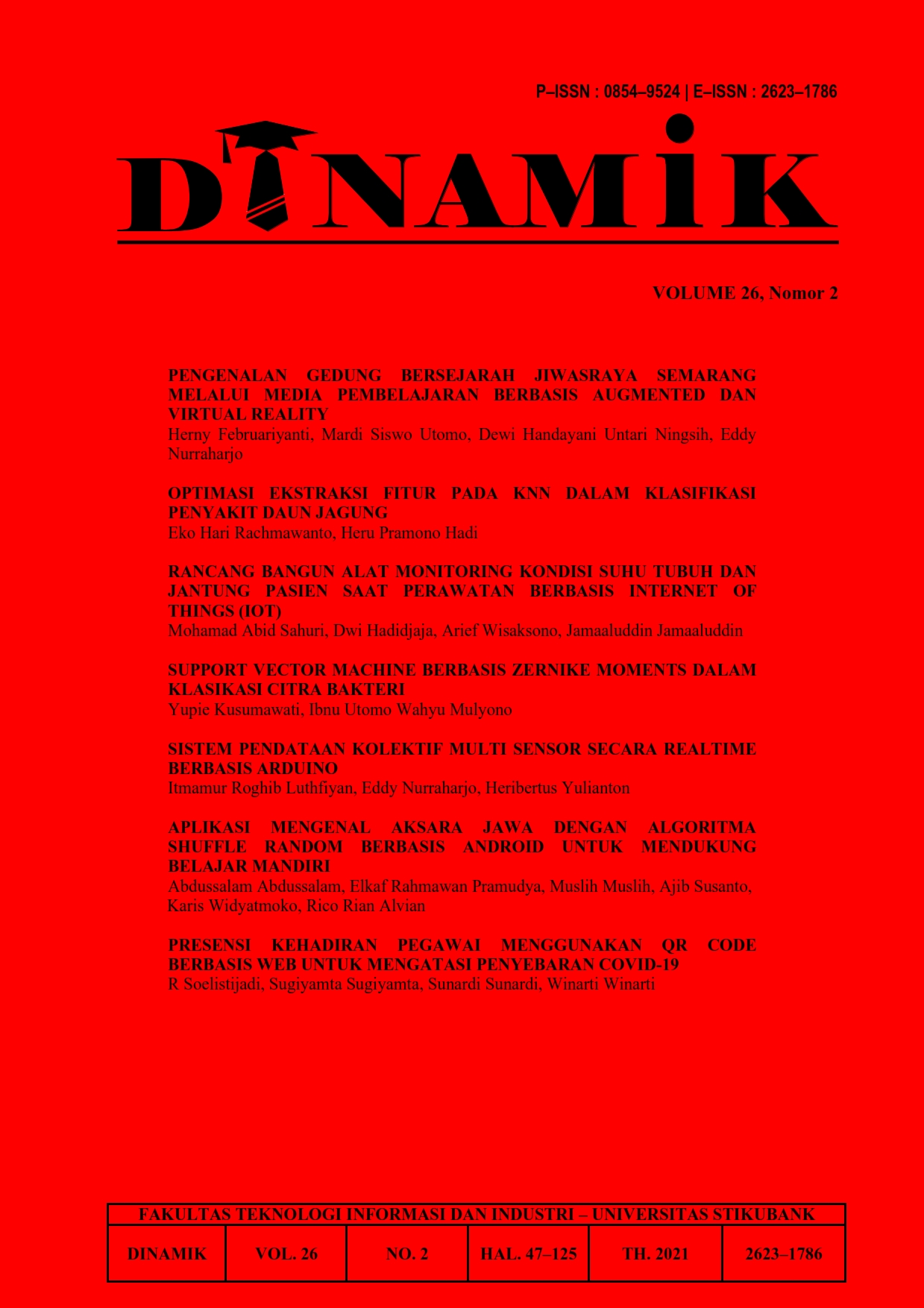RANCANG BANGUN ALAT MONITORING KONDISI SUHU TUBUH DAN JANTUNG PASIEN SAAT PERAWATAN BERBASIS INTERNET OF THINGS (IOT)
Abstract
Monitoring realizes efforts to improve the quality of health services. To obtain information on patient condition data during treatment. The monitoring process is done manually. So that it has an impact on the service and condition of the patient during treatment. The design of monitoring the patient's body temperature and heart during treatment with IoT can be controlled through the NodeMCU sensor ESP8266, MLX9014, MAX30100 sensor and Arduino IDE software program. Furthermore, it can detect the patient's temperature and the patient's heart rate during treatment. And processed by the NodeMCU ESP8266, the data from the two sensors is displayed on the SSD1306 OLED LCD and also to the smartphone of the medical officer on duty via Blynk. In order for the tool to work properly and optimally, it is necessary to adjust the pin placement so that it can work optimally. The problem of internet connection interference causes delays, resulting in a mismatch between the measurement of the test equipment and the standard tool. Data values are taken with an accuracy of 70%-93% for the MAX30100 sensor, for the temperature sensor it is close to optimal with a value that is read on a standard tool with an accuracy of 97%-99%.
References
[2] M. A. Saputro, E. R. Widasari, and H. Fitriyah, “Implementasi Sistem Monitoring Detak Jantung dan Suhu Tubuh Manusia Secara Wireless,” Pengemb. Teknol. Inf. Dan Ilmu Komput., vol. 1, no. 2, pp. 148–156, 2017, [Online]. Available: http://j-ptiik.ub.ac.id/index.php/j-ptiik/article/view/53.
[3] I. Anshory, D. Hadidjaja, and I. Sulistiyowati, “Monitoring Perubahan Tegangan dan Pemodelan Matematika Fungsi Transfer Motor BLDC Dengan System Identification Toolbox Program Studi Teknik Elektro , Fakultas Saintek , Universitas Muhammadiyah Sidoarjo,” pp. 18–25.
[4] I. Prayogo, R. Alfita, and K. A. Wibisono, “Sistem Monitoring Denyut Jantung Dan Suhu Tubuh Sebagai Indikator Level Kesehatan Pasien Berbasis Iot (Internet Of Thing) Dengan Metode Fuzzy Logic Menggunakan Android,” J. Tek. Elektro dan Komput. TRIAC, vol. 4, no. 2, 2017, doi: 10.21107/triac.v4i2.3257.
[5] A. Wisaksono and C. A. Ragil, “Design and Development of Parking Motor Parking Information System at Muhammadiyah University, Sidoarjo,” IOP Conf. Ser. Mater. Sci. Eng., vol. 874, no. 1, 2020, doi: 10.1088/1757-899X/874/1/012015.
[6] A. I. Jamaaluddin, Robandi I, “A very short-term load forecasting in time of peak loads using interval type-2 fuzzy inference system: A case study on java bali electrical system,” J Eng Sci Technol, 2019.
[7] J. Jamaaluddin, I. Robandi, I. Anshory, and A. Fudholi, “Very Short-Term Load Forecasting Of Peak Load Time Using Fuzzy Type-2 And Big Bang Big Crunch (Bbbc) Algorithm,” ARPN J. Eng. Appl. Sci., vol. 15, no. 7, pp. 854–861, 2020.
[8] J. Jamaaluddin, D. Hadidjaja, I. Sulistiyowati, E. A. Suprayitno, I. Anshory, and S. Syahrorini, “Very short term load forecasting peak load time using fuzzy logic,” IOP Conf. Ser. Mater. Sci. Eng., vol. 403, no. 1, 2018, doi: 10.1088/1757-899X/403/1/012070.
[9] R. Bangun, P. Penggunaan, E. Pada, and G. Bertingkat, “Design of Monitoring and Control of Energy Use in Multi-storey Buildings based on IoT,” JEEE-U (Journal Electr. Electron. Eng. UMSIDA, vol. 4, no. 2, pp. 128–135, 2020, doi: 10.21070/jeeeu.v4i2.539.
[10] S. Syahrorini, A. Rifai, D. H. R. Saputra, and A. Ahfas, “Design Smart Chicken Cage Based on Internet of Things,” IOP Conf. Ser. Earth Environ. Sci., vol. 519, no. 1, 2020, doi: 10.1088/1755-1315/519/1/012014.
[11] A. Imron and J. Jamaaluddin, “Rancang Bangun Sistem Informasi Parkir Mobil Otomatis Pada Gedung Bertingkat Berbasis Arduino Mega 2560,” J. Tek. Elektro dan Komput. TRIAC, vol. 4, no. 2, 2017, doi: 10.21107/triac.v4i2.3258.
[12] Y. Kukus, W. Supit, and F. Lintong, “Suhu Tubuh: Homeostasis Dan Efek Terhadap Kinerja Tubuh Manusia,” J. Biomedik, vol. 1, no. 2, 2013, doi: 10.35790/jbm.1.2.2009.824.
[13] T. H. E. Abstract, “Mendeteksi Kesadahan Air Isi Ulang Dengan,” vol. 6, no. 2, pp. 2–7, 2014.
[14] A. Budi and A. S. Khalilullah, “Seminar Proyek Akhir Jurusan Teknik Telekomunikasi PENS-ITS 2010,” Ranc. Bangun Alat Pengukur Detak Jantung dan Suhu Tubuh Mns. Berbas. Komun. Bluetooth, p. 4, 2010, [Online]. Available: http://repo.pens.ac.id/276/.
[15] and U. F. Riyanto, Eddy and , Heru Supriyono, “Perancangan Pengukur Detak Jantung dan Suhu Tubuh Berbasis Arduino serta Smartphone Android,” UNIVERSITAS MUHAMMADIYAH SURAKARTA, 2016.
[16] R. S. Veronika Simbar and A. Syahrin, “Prototype Sistem Monitoring Temperatur Menggunakan Arduino Uno R3 Dengan Komunikasi Wireless,” J. Tek. Mesin, vol. 5, no. 4, p. 48, 2017, doi: 10.22441/jtm.v5i4.1225.
[17] L. B. Setyawan, “Prinsip Kerja dan Teknologi OLED,” Techné J. Ilm. Elektrotek., vol. 16, no. 02, pp. 121–132, 2017, doi: 10.31358/techne.v16i02.165.
[18] boy71 Shed, “ARDUINO UNO AND MAX30100 HEART-RATE MONITOR SENSOR,” 2018. http://www.arduinoprojects.net/sensor-projects/arduino-uno-max30100-heart-rate-monitor-sensor.php (accessed Feb. 25, 2021).
[19] B. N. Laili, B. Destyningtias, M. Eng, and S. Heranurweni, “Rancang Bangun Pulse Oximetry Dengan Sistem Monitoring Internet of Thing ( Iot ),” pp. 1–9, 2019.
[20] Maxim Integrated, “Pulse Oximeter and Heart-Rate Sensor IC for Wearable Health,” Lect. Notes Energy, vol. 38, pp. 1–29, 2014, [Online]. Available: www.maximintegrated.com.
[21] H. P. Yuliza, “Rancang Bangun Kompor Listrik Digital Iot,” vol. 7, no. 3, pp. 187–192, 2016, doi: 10.22441/jte.v7i3.897.









